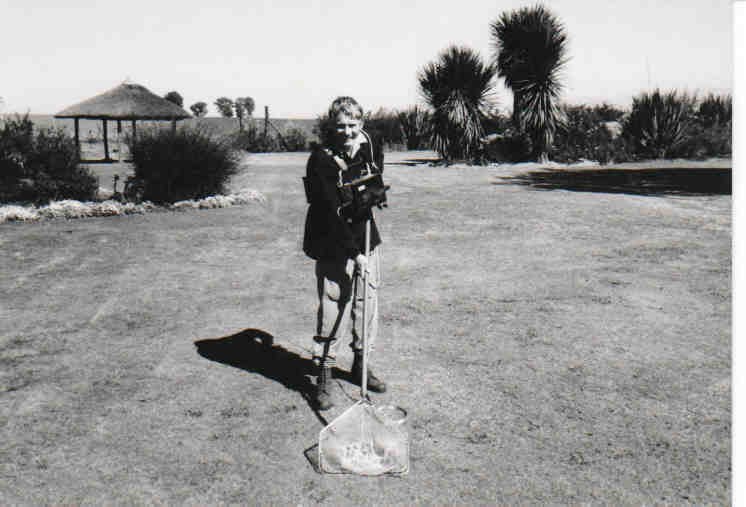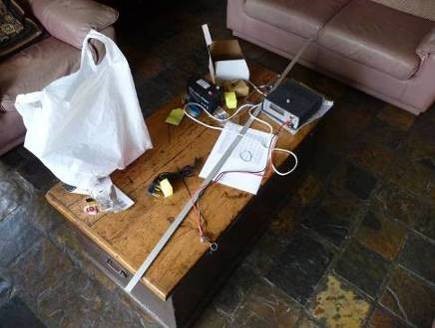Wild Trout Association Electro-fishing Project – Dave Walker
The electro-fishing project has been discussed and in the planning stage for many years and eventually culminated in a proposal prepared by Dave Walker, Ed Herbst, Dr W Bainbridge, Ilan Lax & Jake Alletson in August 2010.

Ed Herbst geared up, way back
The proposal was duly submitted to the Department of Environmental Affairs who subsequently indicated that they approved of the project subject to records being kept of the catch. Unfortunately, a computer crash resulted in the copy of their e-mail being lost. More recently, a copy of the proposal was forwarded to the Department again in 2013 together with a formal application for a permit however, nothing has been heard from them since. Considering the NEMBA fiasco and general shambles in government, this is not surprising.
Research on the internet revealed a variety of e-shockers on the market at prices of around $5000 US. This was obviously beyond our means however, a decision was taken in 2011 to allocate the proceeds of the annual festival auction to establish an electro-shocking fund. Two auctions later plus a fishing visit to Rhodes by Jake Alletson, who provided the name of a European supplier, resulted in the arrival of a very reasonably priced Samus unit.

and another rig from way back used in Natal
Subsequently Alletson kindly sourced the ancillary equipment required such as the net, glass fibre handle and a variety of other odds ‘n ends necessary to convert the unit and parts into a working device. These were brought by him to Rhodes in May 2013. The many parts were assembled resulting in a working electro-fishing unit.


The parts and, excepting the holder Tony Kietzman, the result
And speaking of holders, Maxi Holder, who accompanied Jake to Rhodes, embarked on an SASSI assessment of insects caught by Jake and Tony whilst testing the new rig on a section of the Bell River above and below the bridge at Rhodes.


Jake & Tony about to sample & Jake hard at it
Jake & Tony e-fishing Maxi Holder “SASS-ing”
A second outing was embarked upon to complete the equipment testing phase and continued until Tony found life far too uncomfortable with leaking waders in close proximity to the device! Adequate waders and nets were ordered and supplied to us at cost per kind favour of Frontier Flyfishing. The additional equipment such as waders and nets were specifically to improve the catch rate by way of training two assistants to accompany Kietzman on the water. The 22nd of August 2013 heralded the official start of the project on the farm Eliasdale on the Bokspruit.
Tony Kietzman, Tsekanf Lehanya, Butis Letsika Butis,Tsekang & Tony at it
Based on the catch rate/mphasize, the team’s skills are improving however circumstances such as pool size and depth are a significant factor. A very basic rule of thumb is that long narrow pools tend not to be deep but yield far more than a deep semi-circular pool that is too deep to make effective catches. Since the first tests were conducted, the water has been the proverbial gin clear. More recently, it has dropped to a record low but with plenty of spirogyra to complicate matters.
Once the drought has broken, it will be interesting to see the difference, if any, in the success rate and water conductivity.
|
22-8-2013 |
Trout/km |
|
Eliasdale & Clefthill |
0,0147 |
|
27-8-2013 |
|
|
Lower Hillbury |
0,0027 |
|
3-10-2013 |
|
|
Hillbury, middle |
0,0140 |
|
5-10-2013 |
|
|
Brucedell |
0,1350 |
|
5-10-2013 |
|
|
Gateshead |
0,0567 |
The results of the SASS (South African Scoring System) score that Maxi Holder determined in the Bell River was as follows:
|
|
Stones |
Vegetation |
Gravel |
Composite |
|
|
|
|
|
|
|
Score |
113 |
Not present |
66 |
125 |
|
No. Families |
15 |
11 |
19 |
|
|
Average |
7.1 |
6 |
6.6 |
“Biiological Bands” were used to establish a Present Environmental State for the site. These bands are norms for different parts of the country and are based on the scores obtained in the various areas. Rhodes falls into the Eastern Escarpment Mountains (Upper) Region.
Jake Alletson’s interpretation on the basis of the score obtained and for the composite score in particular, is that the site falls into River Class “B”. This a “largely natural with few modifications” system.
Whereas it was hoped that the survey would result in indicating a Class A system but which was not the case. Several factors work against this, being;
- The recent high flows (floods) which have taken place and that have had an adverse affect on the invertebrate populations.
- The large amount of sediment found in the system. No doubt that this will be linked to the rains that caused the floods but this would indicate that there is an underlying problem. It would seem that the catchment areas are being eroded. Without serious research it cannot be said if this is due to ploughing too close to the river or if it is the result of overgrazing the veld or even inordinate veld burning. Possibly the gravel roads are also contributing some sediment however a combination of all of these factors is most likely.
- Signs of nutrient enrichment were found in the water i.e. patches of algae and the like. This suggests that a low level pollution is present. It may be from agricultural fertilizers but which is unlikely as very few, if any farmers upstream of Rhodes apply fertilizer. A more likely source is from animal and/or possibly human wastes. Again, a combination of all of these factors is most likely.
- It is always suggested that the presence of trout may depress the SASS scores. This might be so but the scientific world has very little idea of what the original state would have been prior to the introduction of trout.
- Although there are many examples of Class A systems elsewhere in south Africa and particularly in KZN, the Bell River sampling at Rhodes revealed the above issues that conspired against a Class A classification.
Although the Bell River is not critically impacted, it would be as well to note that the “canary in the coal mine” is showing signs of stress. The problem will not be easy to solve since intensive agriculture is probably the primary culprit with the other factors kicking in smaller impacts. An all-encompassing awareness campaign focusing attention on the impact of current agricultural practices could go a long way towards alleviating the situation, should any of them be willing to adjust. However, “SASS-ing” other catchments would provide a window to illuminate the bigger picture in the Kraai River catchment.
